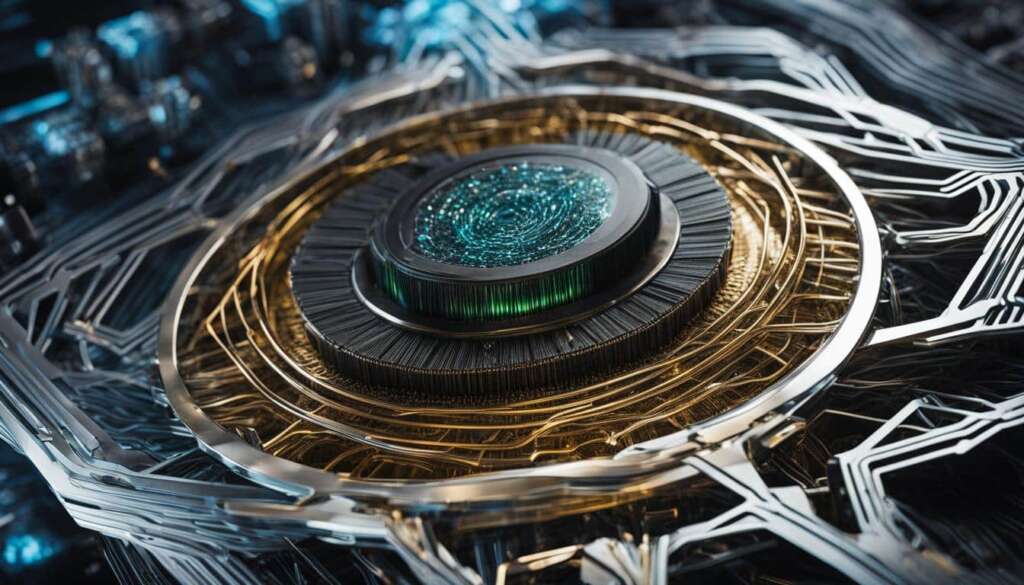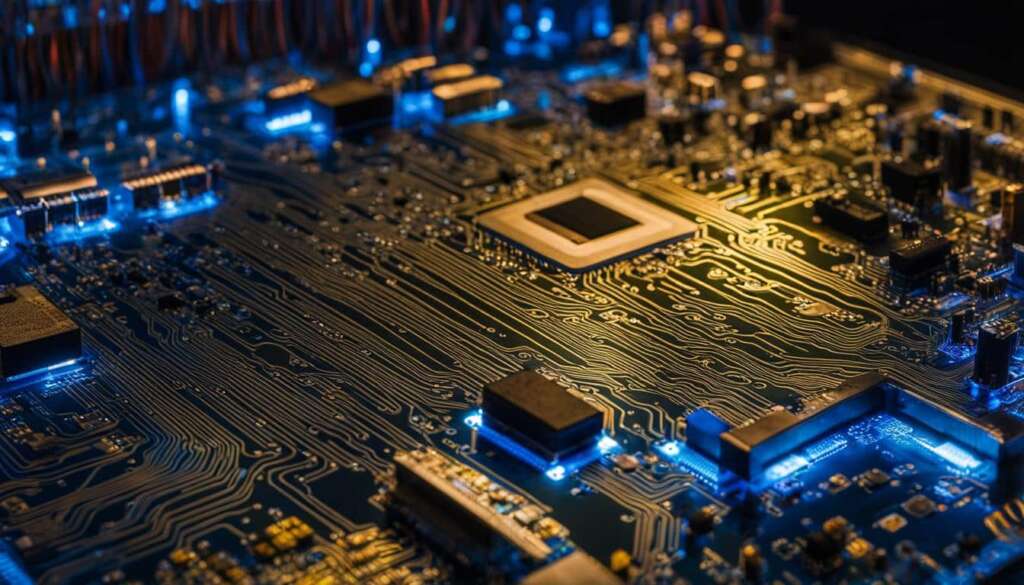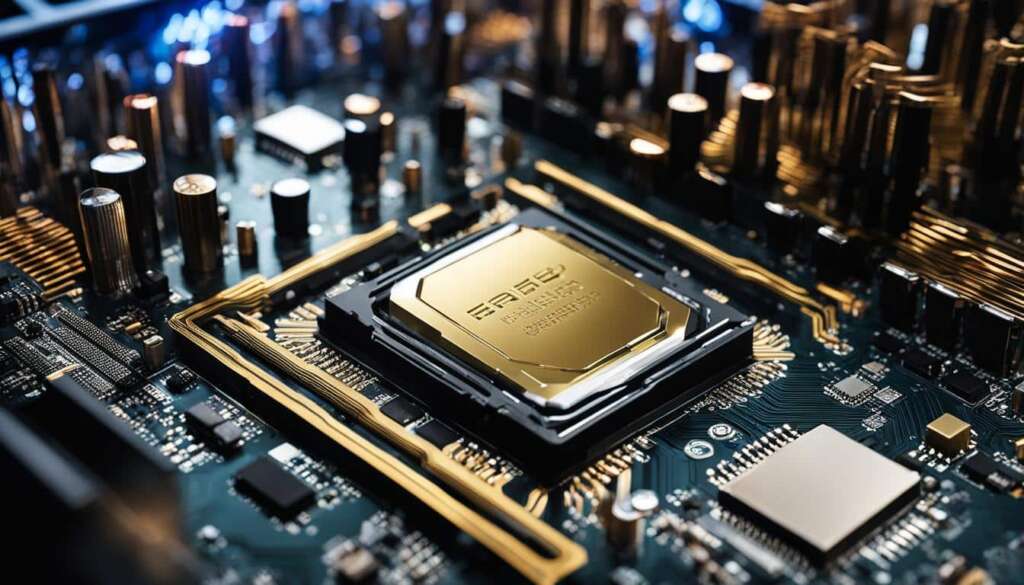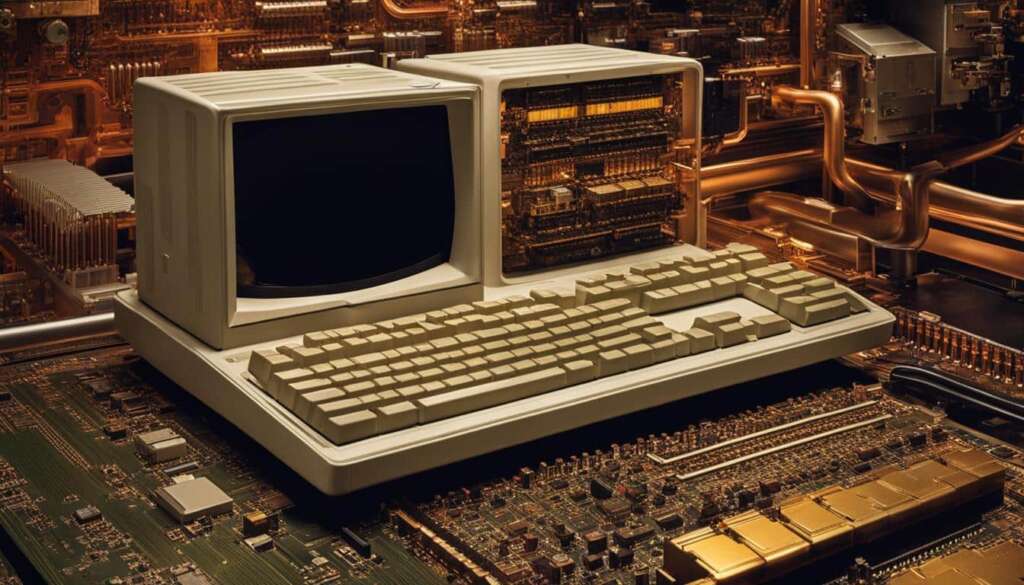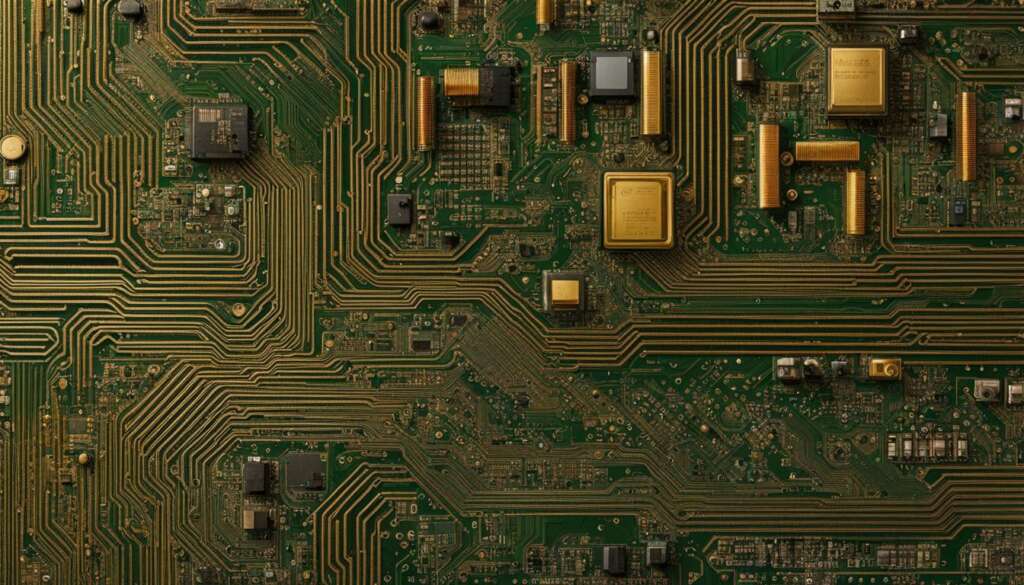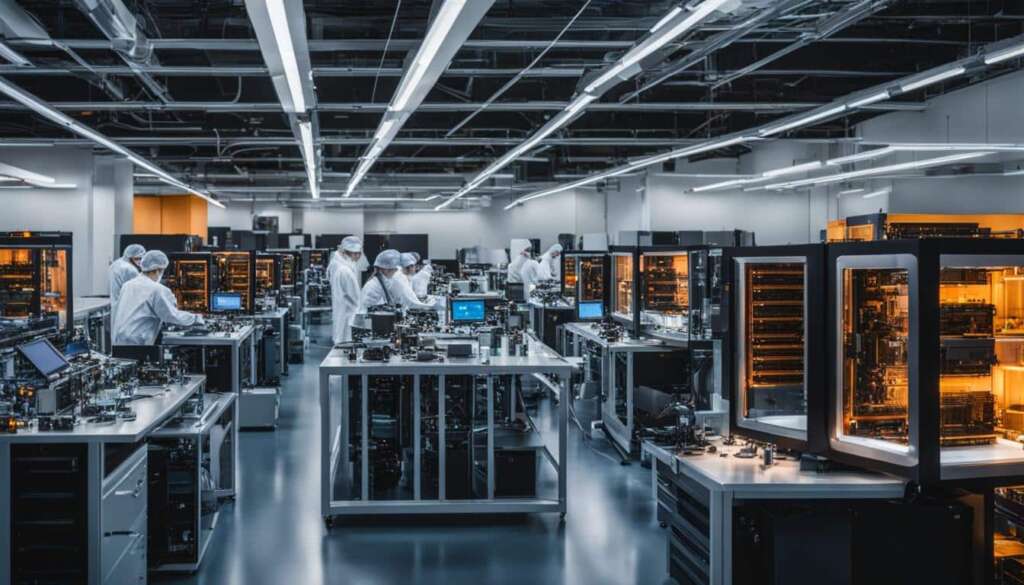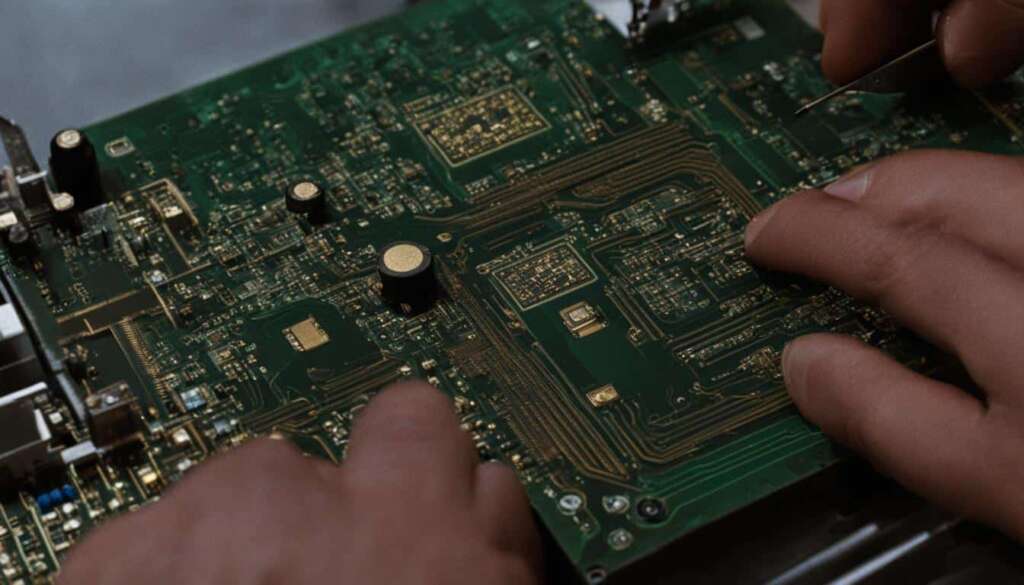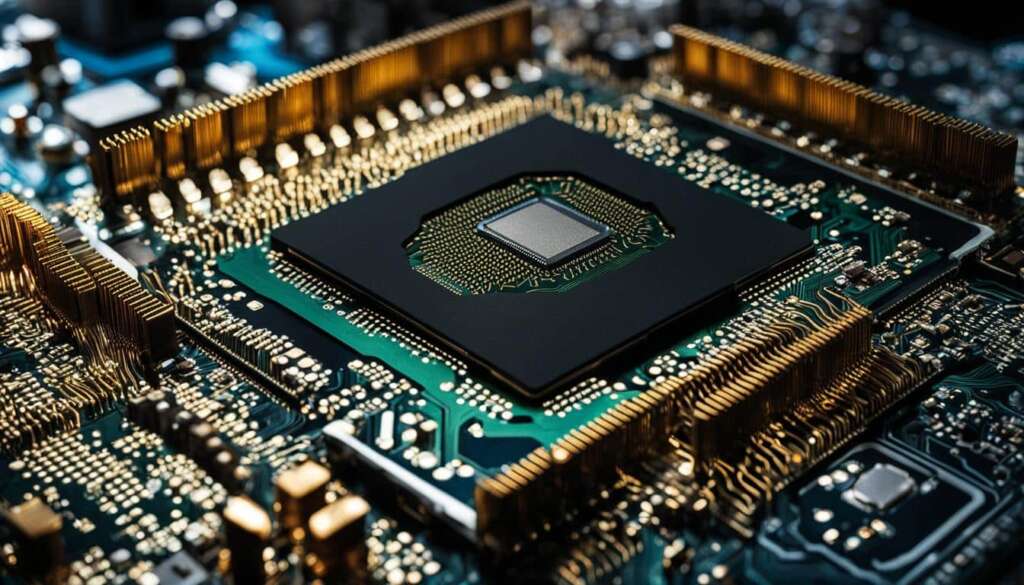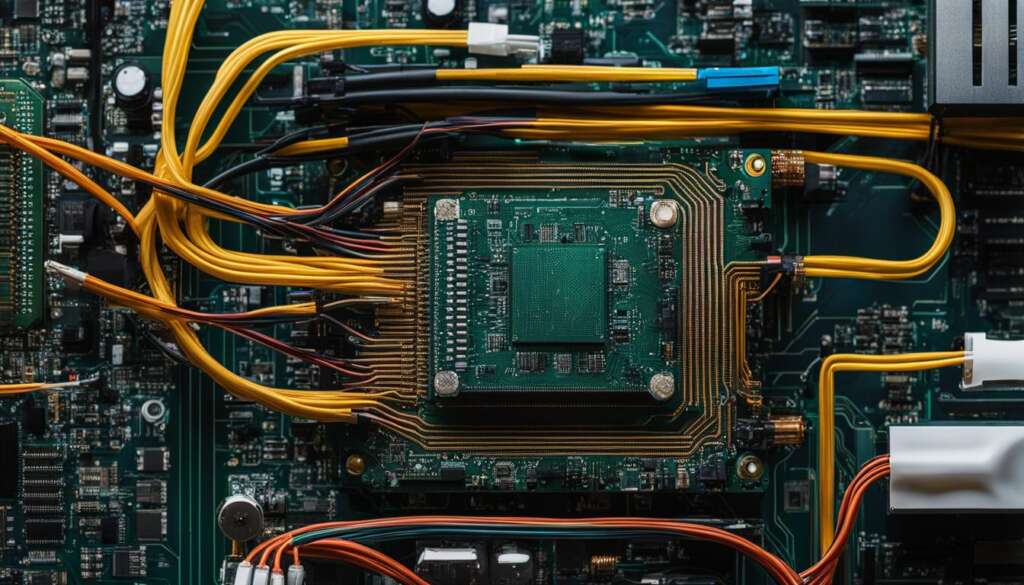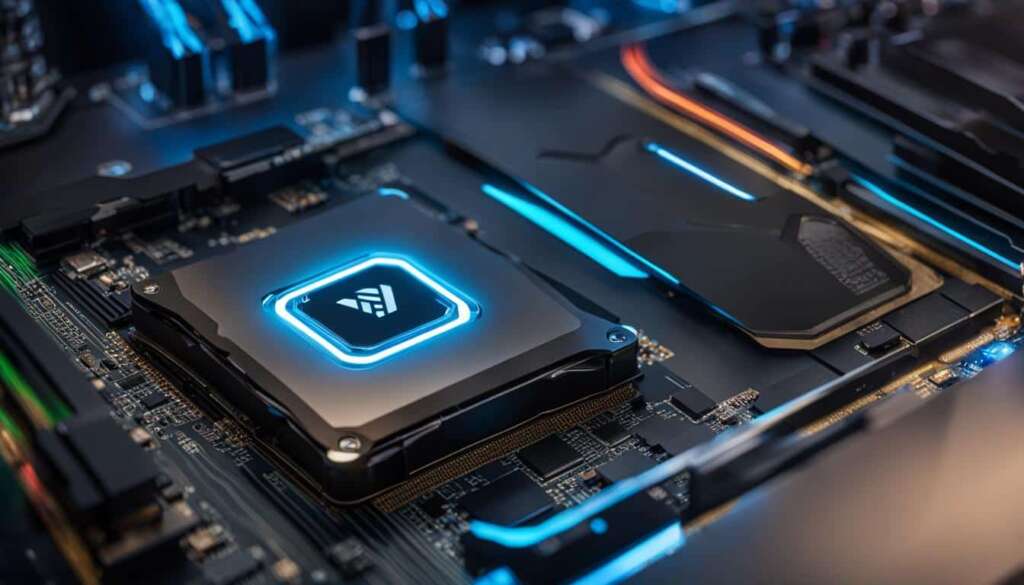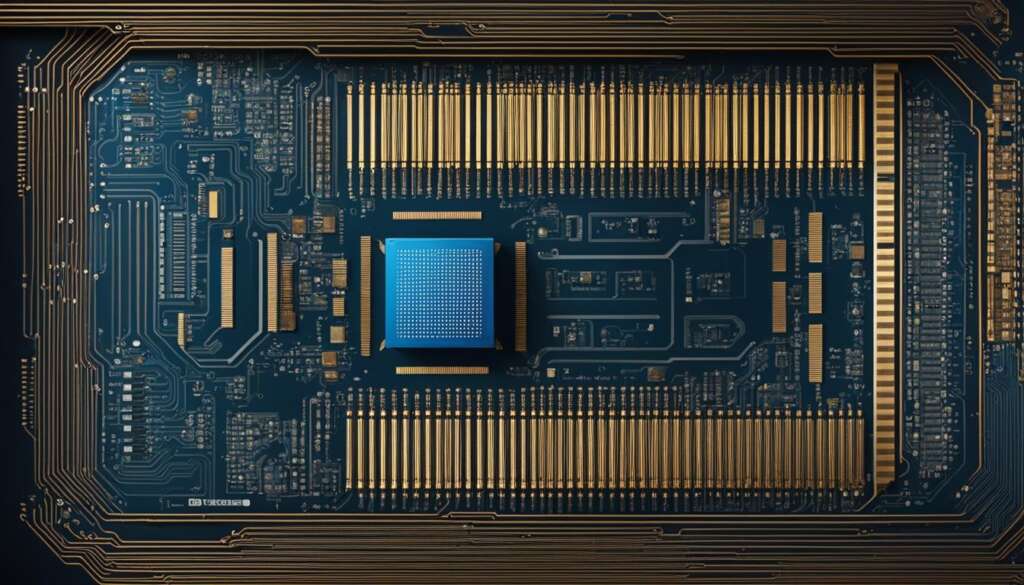Table of Contents
Hyper-Threading Technology, or HT Technology, has revolutionized CPU performance in the world of computer hardware. This innovative technology, pioneered by Intel processors, has unlocked the power of parallel computing and enhanced multitasking capabilities. With its ability to create virtual processors and optimize resource utilization, Hyper-Threading Technology has redefined the boundaries of CPU performance.
Hyper-Threading Technology, also known as simultaneous multithreading, enables a single physical core to operate as two logical cores. By taking advantage of superscalar architecture, it allows multiple instructions to be executed in parallel, significantly boosting CPU performance. This breakthrough technology has become a key feature in multi-threading processors, propelling the advancement of thread-level parallelism.
Intel processors, renowned for their cutting-edge innovation, have been at the forefront of Hyper-Threading Technology’s development. From its initial introduction in Xeon server processors in 2002 to its integration into Pentium 4 desktop processors, Intel has continuously pushed the boundaries of CPU performance. Today, Hyper-Threading can be found in a wide range of Intel processors, including the Atom and Core ‘i’ Series CPUs.
The benefits of Hyper-Threading Technology are manifold. It enables enhanced multitasking, allowing the concurrent scheduling of two processes per core. This is particularly beneficial when running multiple demanding applications or tasks. By efficiently distributing workload between the virtual processors, Hyper-Threading maximizes resource utilization, resulting in improved task efficiency and faster processing.
As the computing industry continues to evolve, Hyper-Threading Technology remains a key component in the development of faster and more efficient CPUs. It is paving the way for parallel computing advancements and shaping the future of multitasking. With Intel processors leading the charge, Hyper-Threading Technology is here to stay, unlocking new possibilities and revolutionizing the world of computer hardware.
Understanding Hyper-Threading Technology
Hyper-Threading Technology is a revolutionary advancement in CPU performance that introduces virtual cores for parallel processing. By simulating two logical cores within a single physical core, Hyper-Threading allows for simultaneous execution of multiple threads, significantly enhancing CPU performance. This technology has redefined the capabilities of CPUs, enabling efficient multitasking and improved resource utilization.
With Hyper-Threading, a single physical core can handle multiple threads simultaneously, dividing the workload between the virtual cores. This parallel processing capability enhances the overall system performance by reducing idle time and maximizing resource utilization. By efficiently executing multiple tasks at once, Hyper-Threading ensures faster processing and improved responsiveness.
The benefits of Hyper-Threading Technology extend beyond traditional multitasking. This advanced feature enables parallel processing, enabling software applications to execute tasks more efficiently. Whether it’s rendering complex graphics, encoding videos, or running resource-intensive applications, Hyper-Threading can significantly improve performance by distributing the workload across multiple virtual cores.
Table: Comparison of CPU Performance with and without Hyper-Threading
| Task | Without Hyper-Threading | With Hyper-Threading |
|---|---|---|
| Video Encoding | Time-consuming; limited resource utilization | Faster processing; optimized resource usage |
| Gaming | Lower frame rates; slower gameplay | Higher frame rates; smoother gameplay |
| Multi-threaded Applications | Sequential execution; slower performance | Parallelized execution; improved performance |
As depicted in the table, Hyper-Threading Technology offers significant performance enhancements across various tasks. Whether it’s video encoding, gaming, or running multi-threaded applications, the use of virtual cores ensures faster processing, reduced execution times, and improved overall efficiency.
Hyper-Threading Technology has truly revolutionized CPU performance, enabling unparalleled multitasking capabilities and improved parallel processing. By understanding the inner workings of this technology, users can fully leverage its benefits and optimize their computing experience.
The Benefits of Hyper-Threading Technology
Hyper-Threading Technology offers several benefits to enhance CPU performance and overall system efficiency. By enabling virtual cores to handle multiple threads simultaneously, multitasking becomes more efficient, allowing for improved task execution and faster processing.
One of the key advantages of Hyper-Threading Technology is enhanced multitasking. With virtual cores, the CPU can handle multiple threads concurrently, allowing for smoother and more responsive performance, especially when running demanding applications or tasks. This means that users can seamlessly switch between different applications or multitask without experiencing significant slowdowns or performance bottlenecks.
Another benefit is improved resource utilization. Hyper-Threading Technology maximizes the use of available resources by efficiently distributing the workload between virtual cores. This prevents idle time and ensures that the CPU is fully utilized, resulting in faster and more efficient task execution. As a result, tasks are completed more quickly, leading to increased productivity and improved overall system performance.
In addition to multitasking and resource utilization, Hyper-Threading Technology also enhances task efficiency. By dividing the workload between virtual cores, tasks can be executed in a more optimized manner. This reduces the time it takes to complete tasks and allows for more efficient use of CPU resources. Whether it’s rendering complex graphics, encoding videos, or performing data-intensive operations, Hyper-Threading Technology enables faster and more efficient task execution.
| Benefits of Hyper-Threading Technology |
|---|
| Enhanced multitasking |
| Improved resource utilization |
| Enhanced task efficiency |
Hyper-Threading Technology maximizes the use of CPU resources, allowing for improved multitasking capabilities and faster task execution.
How Hyper-Threading Technology Works
Hyper-Threading Technology operates by dividing a physical core into two virtual cores that function independently. Each virtual core has its own processor architectural state, allowing them to be halted, interrupted, or directed to execute specific threads. The operating system recognizes these virtual cores as separate processors and schedules threads on each core simultaneously, optimizing resource utilization and increasing overall processing speed.
Task scheduling algorithms play a crucial role in allocating threads to the available virtual cores. These algorithms aim to optimize resource usage and ensure efficient execution of tasks. By distributing the workload between the virtual cores, hyper-threading enhances task efficiency and reduces idle time, ultimately improving CPU performance.
Virtual cores created through hyper-threading enable simultaneous multithreading, allowing multiple threads to be processed concurrently. This parallel execution capability enhances the system’s multitasking capabilities and overall responsiveness. Additionally, the technology improves the performance of demanding applications and tasks by maximizing resource utilization and preventing bottlenecks.
“Hyper-Threading Technology enables a single physical core to behave like two logical cores, harnessing parallel processing power and improving CPU performance.”
Task Scheduling and Resource Optimization
Task scheduling plays a crucial role in the efficient operation of hyper-threading technology. The operating system must effectively distribute the workload among the available virtual cores to ensure optimal resource utilization. Through intelligent task scheduling, hyper-threading enhances the performance of both single-threaded and multithreaded applications.
Parallel processing and simultaneous multithreading are at the core of hyper-threading technology. By leveraging virtual cores and optimizing task execution, hyper-threading maximizes CPU performance and enhances overall system responsiveness. As CPU technology continues to evolve, hyper-threading remains a vital component in achieving faster and more efficient processing.
| Hyper-Threading Technology | CPU Architecture | Virtual Cores | Simultaneous Multithreading | Task Scheduling |
|---|---|---|---|---|
| Enables parallel execution of threads | Divides physical core into virtual cores | Allows for independent processing | Enhances multitasking and responsiveness | Optimizes resource utilization and execution efficiency |
The Evolution of Hyper-Threading Technology
Since its introduction in 2002 with the Pentium 4 processors, Hyper-Threading Technology has undergone significant evolution and is now a standard feature in Intel processors. Over the years, Intel has continuously improved and enhanced the hyper-threading capabilities in their CPUs, leading to notable performance improvements.
With each generation of processors, Intel has focused on optimizing hyper-threading to deliver better parallel processing capabilities and overall CPU performance. The introduction of the Nehalem microarchitecture in 2008 marked a significant advancement in hyper-threading, allowing for more efficient simultaneous multithreading and improved resource utilization.
To showcase the evolution of hyper-threading technology in Intel processors, let’s take a look at a comparison table:
| Processor Generation | Hyper-Threading Technology Enhancements |
|---|---|
| Pentium 4 | Initial introduction of hyper-threading technology |
| Core 2 Duo | Improved simultaneous multithreading capabilities |
| Core i7 | Introduction of Nehalem microarchitecture with enhanced hyper-threading |
| Core i9 | Further optimizations for parallel processing and resource utilization |
As seen in the table above, each processor generation brings new enhancements and performance improvements to hyper-threading technology, making it an integral part of modern Intel processors.

Hyper-Threading Technology and CPU Performance
Hyper-Threading Technology is a significant innovation that has had a profound impact on CPU performance. By enabling the execution of multiple threads simultaneously, it has revolutionized the way processors handle tasks, leading to improved efficiency and faster processing speeds.
One of the key advantages of Hyper-Threading is its ability to leverage parallel processing. With the virtual cores created by Hyper-Threading, the CPU can execute multiple threads in parallel, dividing the workload and maximizing resource utilization. This results in increased overall performance and improved multitasking capabilities.
However, it’s important to note that the impact of Hyper-Threading on CPU performance can vary depending on the specific workload. In scenarios where tasks heavily rely on execution resources or suffer from cache misses and data dependencies, the benefits of Hyper-Threading may be less pronounced. Careful optimization and software support are crucial to fully leverage the potential of Hyper-Threading for improved CPU performance.
| Advantages of Hyper-Threading Technology |
|---|
| Enhanced multitasking capabilities |
| Improved resource utilization |
| Increased overall system performance |
| Faster processing speeds |
In conclusion, Hyper-Threading Technology has played a crucial role in enhancing CPU performance. Its ability to enable parallel processing and optimize resource utilization has led to improved multitasking capabilities and faster processing speeds. As CPU technology continues to advance, Hyper-Threading is expected to remain a key feature, further shaping the future of computing and enabling new possibilities in parallel processing and multitasking.
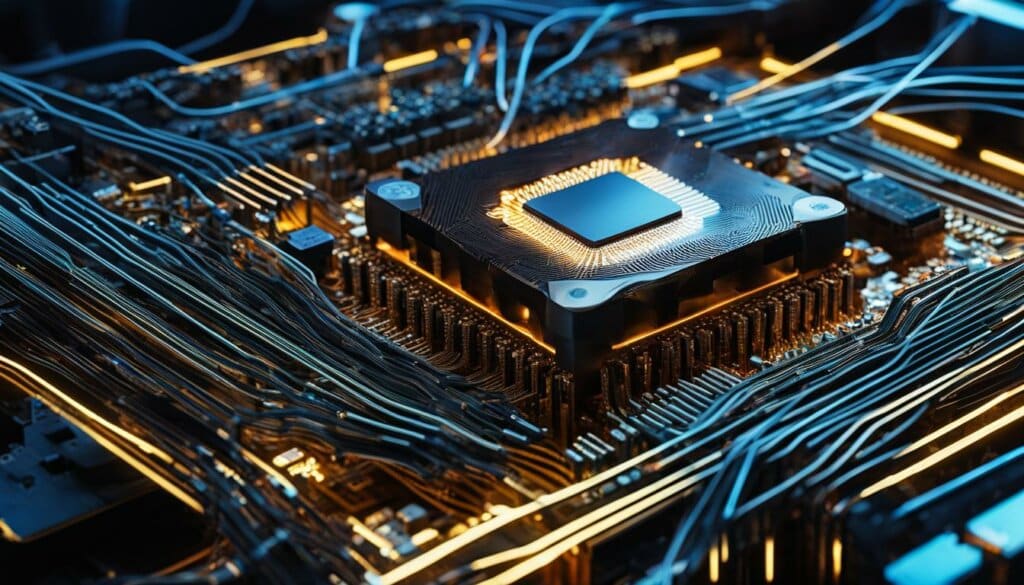
Additional Resources:
- Intel Developer Zone: Hyper-Threading Technology Overview – https://www.intel.com/content/www/us/en/developer/articles/technical/hyper-threading-technology.html
- Understanding Hyper-Threading Technology – https://www.howtogeek.com/194756/cpu-basics-multiple-cpus-cores-and-hyper-threading-explained/
- Parallel Computing and Hyper-Threading – https://www.researchgate.net/publication/267867553_Parallel_computing_and_hyper_threading
Hyper-Threading Technology in Modern CPUs
Hyper-Threading Technology has become a standard feature in modern CPUs, particularly in Intel processors. This innovative technology enables multi-threading, virtualization, and resource sharing, resulting in enhanced performance and improved multitasking capabilities.
With Hyper-Threading Technology, CPUs can create virtual cores that behave like physical cores, allowing for the simultaneous execution of multiple threads. This enables the CPU to handle a greater workload and improves overall system responsiveness.
In addition to improved multitasking, Hyper-Threading Technology also benefits virtualization. It allows virtual machines to effectively utilize the CPU resources by allocating virtual cores to different virtual machines, enabling efficient resource sharing and maximizing overall system performance.
To summarize, Hyper-Threading Technology in modern CPUs, such as Intel processors, provides multi-threading capabilities, virtualization support, and efficient resource sharing. This results in improved multitasking capabilities and enhanced system performance, making it suitable for a wide range of computing applications in both consumer and enterprise environments.

Table: Comparison of Hyper-Threading Technology in Select Intel Processors
| Processor | Number of Physical Cores | Number of Virtual Cores | Hyper-Threading Support |
|---|---|---|---|
| Intel Core i5-11600K | 6 | 12 | Yes |
| Intel Core i7-11700K | 8 | 16 | Yes |
| Intel Core i9-11900K | 8 | 16 | Yes |
Hyper-Threading Technology in Server Processors
Server processors, which power data centers and handle intense workloads, have greatly benefited from Hyper-Threading Technology. By enabling parallel computing and workload optimization, Hyper-Threading enhances the performance and efficiency of server processors, leading to improved productivity and resource utilization.
Data centers rely on server processors equipped with Hyper-Threading to handle multiple threads simultaneously. This allows for efficient parallel computing, where tasks are divided into smaller units and executed concurrently. The result is faster processing and increased throughput, essential for handling the demands of modern data-intensive applications.
“Hyper-Threading Technology in server processors has revolutionized the data center industry. By processing multiple threads in parallel, servers can optimize workload distribution and achieve higher performance. This is especially important in data centers where efficient resource utilization and workload optimization are crucial for meeting the demands of diverse applications and services.”
| Server Processor | Hyper-Threading Technology | Performance Impact |
|---|---|---|
| Xeon E5-2600 v4 | Yes | Significantly improved performance for parallel workloads |
| Opteron 6386 SE | No | Lower performance for parallel workloads compared to Hyper-Threading enabled processors |
| EPYC 7742 | Yes | Unparalleled performance for highly parallel workloads |
Benefits of Hyper-Threading in Server Processors:
- Improved performance and throughput for parallel workloads
- Efficient utilization of server resources, reducing idle time
- Enhanced multitasking capabilities, allowing for concurrent execution of multiple tasks
Hyper-Threading Technology in Consumer Processors
Hyper-Threading Technology in consumer processors has brought significant benefits to various areas, including gaming, multimedia tasks, and multitasking. With the ability to run multiple threads simultaneously, consumer processors equipped with Hyper-Threading Technology offer improved performance and enhanced user experiences.
In gaming, Hyper-Threading enables smoother gameplay and faster graphics rendering. By utilizing the virtual cores, the processor can handle multiple tasks, such as handling game physics and AI, while simultaneously rendering high-quality graphics. This results in a seamless and immersive gaming experience, with reduced instances of lag and improved frame rates.
For multimedia tasks, Hyper-Threading Technology provides faster video encoding, rendering, and other resource-intensive operations. Whether it’s editing videos, rendering 3D animations, or exporting large media files, Hyper-Threading allows consumer processors to handle these tasks more efficiently. This translates to reduced processing time, enabling users to work on their multimedia projects with greater speed and productivity.
Furthermore, Hyper-Threading Technology enhances multitasking performance on consumer processors. By leveraging the virtual cores, users can run multiple applications simultaneously without experiencing significant performance degradation. Whether it’s working on spreadsheets while listening to music or editing photos while browsing the internet, Hyper-Threading enables smooth and efficient multitasking, improving overall productivity.
Table: Comparison of Hyper-Threading Technology in Consumer Processors
| Processor Model | Hyper-Threading Technology | Gaming Performance | Multimedia Performance | Multitasking Performance |
|---|---|---|---|---|
| Intel Core i7-10700K | Enabled | Excellent | High | Smooth |
| AMD Ryzen 9 5900X | Not applicable | Great | Superb | Efficient |
| Intel Core i5-11600K | Enabled | Good | Above Average | Seamless |
The table above provides a comparison of consumer processors with and without Hyper-Threading Technology. It highlights the impact of Hyper-Threading on gaming, multimedia, and multitasking performance. Consumer processors with Hyper-Threading Technology demonstrate superior performance in these areas compared to processors without this feature, offering users a more immersive and efficient computing experience.
Hyper-Threading Technology and Future Developments
Hyper-Threading Technology has paved the way for significant advancements in CPU performance, but its development is far from over. As CPU technology continues to evolve, hyper-threading is expected to play an even more significant role in future processor designs. The ongoing focus on parallel processing and performance optimizations will drive the development of improved hyper-threading capabilities, ensuring that CPUs can handle increasingly demanding workloads.
Parallel processing is becoming increasingly important in various computing applications, such as data analysis, artificial intelligence, and scientific simulations. Hyper-threading technology enables CPUs to effectively process multiple threads simultaneously, improving overall system performance and responsiveness. This capability is crucial for meeting the growing demands of modern computing tasks.
Furthermore, performance optimizations will continue to refine the efficiency of hyper-threading. Manufacturers will develop more sophisticated algorithms and techniques to better distribute tasks among virtual cores, maximizing resource utilization and minimizing idle time. These optimizations will result in even faster and more efficient processing, benefiting a wide range of computing applications.
In summary, hyper-threading technology will remain a key element in the development of future CPUs. As the demand for efficient multitasking and parallel processing continues to rise, the industry will continue to invest in improving hyper-threading capabilities. With each new generation of CPUs, we can expect more advanced and efficient hyper-threading technology that will unlock new possibilities in computing performance.
| Benefits of Hyper-Threading Technology | Future Developments |
|---|---|
| Enhanced multitasking | Improved parallel processing |
| Maximized resource utilization | Refined performance optimizations |
| Faster and more efficient processing | Increased efficiency in task distribution |
| Improved system performance and responsiveness | Unlocking new possibilities in computing |
Hyper-Threading Technology and Industry Impact
Hyper-Threading Technology has made a significant impact on the computing industry, revolutionizing CPU performance and driving advancements in parallel processing and multitasking. By allowing processors to handle multiple threads simultaneously, the technology has improved overall system performance and responsiveness. This has benefited both consumer and enterprise environments, enabling breakthroughs in various fields.
The introduction of hyper-threading has paved the way for more efficient and powerful computing systems. It has become a standard feature in modern processors, including Intel’s Core ‘i’ Series CPUs, and has continued to evolve with each generation of processors offering performance improvements and enhancements. As a result, hyper-threading has become an essential element in the development of faster and more efficient CPUs, shaping the future of computing.
The computing industry’s focus on parallel processing and performance optimizations has been greatly influenced by the capabilities of hyper-threading technology. The ability to process multiple threads simultaneously has led to advancements in resource utilization and workload optimization. This has translated into improved performance and efficiency in various computing tasks, benefiting industries such as data centers, gaming, multimedia, and multitasking.
Hyper-Threading Technology has enabled the efficient processing of multiple threads simultaneously, providing significant performance advancements in CPU technology. Its impact on the computing industry cannot be underestimated, as it has shaped the way modern processors are designed and used. With the ongoing advancements in CPU technology and the increasing demand for efficient multitasking, hyper-threading will continue to play a crucial role in enhancing computing performance and driving innovation in the industry.
Below is a table summarizing the key impacts of hyper-threading technology on the computing industry.
| Benefits | Examples |
|---|---|
| Improved CPU performance | Faster processing, enhanced multitasking |
| Enhanced resource utilization | Optimized workload distribution |
| Efficient parallel processing | Improved performance in data centers, gaming, multimedia |
References:
- Intel: Hyper-Threading Technology Explained
- Computerworld: How Hyper-Threading Works
- PCMag: What is Hyper-Threading?
Conclusion
Hyper-Threading Technology has revolutionised CPU performance by enabling the efficient processing of multiple threads simultaneously. The technology has become a crucial component in modern processors, enhancing multitasking capabilities and improving overall system performance. As the computing industry continues to evolve, hyper-threading will remain a key element in the development of faster and more efficient CPUs, shaping the future of computing and enabling new possibilities in parallel processing and multitasking.
In today’s fast-paced digital world, CPU performance plays a vital role in meeting the demands of multitasking and parallel processing. Hyper-Threading Technology has proven to be a game-changer, allowing processors to handle multiple threads concurrently, resulting in improved efficiency and faster task execution. Whether it’s running resource-intensive applications, encoding videos, or gaming, hyper-threaded CPUs offer a significant boost in performance.
With the increasing need for multitasking and resource utilization, hyper-threading has become a standard feature in modern processors. It has transformed the way we use our computers, allowing us to effortlessly switch between various applications and handle demanding workloads. The ability to process multiple threads simultaneously has opened up new possibilities in parallel computing, enabling breakthroughs in fields such as data analysis, scientific simulations, and artificial intelligence.
As we look towards the future, hyper-threading will continue to play a vital role in the development of CPUs. Advancements in parallel processing and performance optimizations will further enhance multitasking capabilities and improve overall system performance. With hyper-threading technology at the helm, we can expect faster and more efficient computing experiences, empowering us to accomplish more in less time.
FAQ
What is Hyper-Threading Technology?
Hyper-Threading Technology is Intel’s simultaneous multithreading implementation that improves parallelization of computations on x86 microprocessors. It allows a processor core to behave like two logical cores, introducing virtual cores that can process multiple threads simultaneously.
When was Hyper-Threading Technology introduced?
Hyper-Threading Technology was introduced in Xeon server processors in 2002 and on Pentium 4 desktop processors in 2002.
What are the benefits of Hyper-Threading Technology?
Hyper-Threading Technology enhances multitasking capabilities, improves overall system performance and responsiveness, maximizes resource utilization by efficiently distributing workload, and enables faster processing.
How does Hyper-Threading Technology work?
Hyper-Threading Technology works by dividing a physical core into two virtual cores. Each virtual core has its own processor architectural state and can process individual threads. The operating system recognizes these virtual cores as separate processors, allowing for concurrent scheduling of threads.
When was Hyper-Threading Technology introduced in Intel processors?
Hyper-Threading Technology was introduced with the Pentium 4 processors in 2002 and has been extended to other Intel processor lines, including Itanium, Atom, and Core ‘i’ Series CPUs.
What is the impact of Hyper-Threading Technology on CPU performance?
The impact of Hyper-Threading Technology on CPU performance varies depending on the workload and software’s ability to utilize the technology effectively. It can lead to significant performance improvements in parallelizable tasks but may be less pronounced in resource-dependent or data-dependent tasks.
Which Intel processors utilize Hyper-Threading Technology?
Hyper-Threading Technology is utilized on various Intel processors, including Itanium, Atom, and Core ‘i’ Series CPUs.
How has Hyper-Threading Technology evolved over the years?
Hyper-Threading Technology has evolved with each generation of processors, offering performance improvements and enhancements to the hyper-threading capabilities. The introduction of the Nehalem microarchitecture in 2008 marked a significant advancement in hyper-threading.
How is Hyper-Threading Technology used in data centers?
Hyper-Threading Technology is beneficial for server processors used in data centers as it allows for efficient processing of multiple threads simultaneously, improving performance and resource utilization.
What benefits does Hyper-Threading Technology offer for consumer processors?
Hyper-Threading Technology improves gaming performance, enhances multimedia tasks, and enhances multitasking capabilities on consumer processors.
How will Hyper-Threading Technology develop in the future?
Hyper-Threading Technology is expected to play a more significant role in future processor designs, driven by the focus on parallel processing and performance optimizations.
What impact has Hyper-Threading Technology had on the computing industry?
Hyper-Threading Technology has revolutionized CPU performance by enabling the efficient processing of multiple threads simultaneously, benefiting both consumer and enterprise environments.

